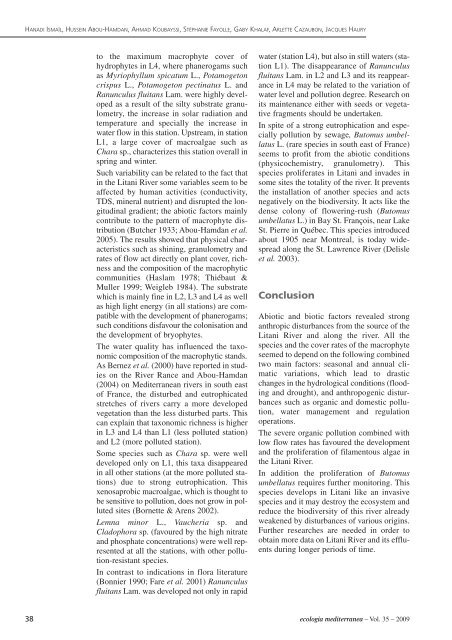Vol. 35 – 2009 - Ecologia Mediterranea - Université d'Avignon et des ...
Vol. 35 – 2009 - Ecologia Mediterranea - Université d'Avignon et des ...
Vol. 35 – 2009 - Ecologia Mediterranea - Université d'Avignon et des ...
You also want an ePaper? Increase the reach of your titles
YUMPU automatically turns print PDFs into web optimized ePapers that Google loves.
HANADI ISMAÏL, HUSSEIN ABOU-HAMDAN, AHMAD KOUBAYSSI, STÉPHANIE FAYOLLE, GABY KHALAF, ARLETTE CAZAUBON, JACQUES HAURY<br />
38<br />
to the maximum macrophyte cover of<br />
hydrophytes in L4, where phanerogams such<br />
as Myriophyllum spicatum L., Potamog<strong>et</strong>on<br />
crispus L., Potamog<strong>et</strong>on pectinatus L. and<br />
Ranunculus fluitans Lam. were highly developed<br />
as a result of the silty substrate granulom<strong>et</strong>ry,<br />
the increase in solar radiation and<br />
temperature and specially the increase in<br />
water flow in this station. Upstream, in station<br />
L1, a large cover of macroalgae such as<br />
Chara sp., characterizes this station overall in<br />
spring and winter.<br />
Such variability can be related to the fact that<br />
in the Litani River some variables seem to be<br />
affected by human activities (conductivity,<br />
TDS, mineral nutrient) and disrupted the longitudinal<br />
gradient; the abiotic factors mainly<br />
contribute to the pattern of macrophyte distribution<br />
(Butcher 1933; Abou-Hamdan <strong>et</strong> al.<br />
2005). The results showed that physical characteristics<br />
such as shining, granulom<strong>et</strong>ry and<br />
rates of flow act directly on plant cover, richness<br />
and the composition of the macrophytic<br />
communities (Haslam 1978; Thiébaut &<br />
Muller 1999; Weigleb 1984). The substrate<br />
which is mainly fine in L2, L3 and L4 as well<br />
as high light energy (in all stations) are compatible<br />
with the development of phanerogams;<br />
such conditions disfavour the colonisation and<br />
the development of bryophytes.<br />
The water quality has influenced the taxonomic<br />
composition of the macrophytic stands.<br />
As Bernez <strong>et</strong> al. (2000) have reported in studies<br />
on the River Rance and Abou-Hamdan<br />
(2004) on <strong>Mediterranea</strong>n rivers in south east<br />
of France, the disturbed and eutrophicated<br />
str<strong>et</strong>ches of rivers carry a more developed<br />
veg<strong>et</strong>ation than the less disturbed parts. This<br />
can explain that taxonomic richness is higher<br />
in L3 and L4 than L1 (less polluted station)<br />
and L2 (more polluted station).<br />
Some species such as Chara sp. were well<br />
developed only on L1, this taxa disappeared<br />
in all other stations (at the more polluted stations)<br />
due to strong eutrophication. This<br />
xenosaprobic macroalgae, which is thought to<br />
be sensitive to pollution, does not grow in polluted<br />
sites (Born<strong>et</strong>te & Arens 2002).<br />
Lemna minor L., Vaucheria sp. and<br />
Cladophora sp. (favoured by the high nitrate<br />
and phosphate concentrations) were well represented<br />
at all the stations, with other pollution-resistant<br />
species.<br />
In contrast to indications in flora literature<br />
(Bonnier 1990; Fare <strong>et</strong> al. 2001) Ranunculus<br />
fluitans Lam. was developed not only in rapid<br />
water (station L4), but also in still waters (station<br />
L1). The disappearance of Ranunculus<br />
fluitans Lam. in L2 and L3 and its reappearance<br />
in L4 may be related to the variation of<br />
water level and pollution degree. Research on<br />
its maintenance either with seeds or veg<strong>et</strong>ative<br />
fragments should be undertaken.<br />
In spite of a strong eutrophication and especially<br />
pollution by sewage, Butomus umbellatus<br />
L. (rare species in south east of France)<br />
seems to profit from the abiotic conditions<br />
(physicochemistry, granulom<strong>et</strong>ry). This<br />
species proliferates in Litani and inva<strong>des</strong> in<br />
some sites the totality of the river. It prevents<br />
the installation of another species and acts<br />
negatively on the biodiversity. It acts like the<br />
dense colony of flowering-rush (Butomus<br />
umbellatus L.) in Bay St. François, near Lake<br />
St. Pierre in Québec. This species introduced<br />
about 1905 near Montreal, is today wi<strong>des</strong>pread<br />
along the St. Lawrence River (Delisle<br />
<strong>et</strong> al. 2003).<br />
Conclusion<br />
Abiotic and biotic factors revealed strong<br />
anthropic disturbances from the source of the<br />
Litani River and along the river. All the<br />
species and the cover rates of the macrophyte<br />
seemed to depend on the following combined<br />
two main factors: seasonal and annual climatic<br />
variations, which lead to drastic<br />
changes in the hydrological conditions (flooding<br />
and drought), and anthropogenic disturbances<br />
such as organic and domestic pollution,<br />
water management and regulation<br />
operations.<br />
The severe organic pollution combined with<br />
low flow rates has favoured the development<br />
and the proliferation of filamentous algae in<br />
the Litani River.<br />
In addition the proliferation of Butomus<br />
umbellatus requires further monitoring. This<br />
species develops in Litani like an invasive<br />
species and it may <strong>des</strong>troy the ecosystem and<br />
reduce the biodiversity of this river already<br />
weakened by disturbances of various origins.<br />
Further researches are needed in order to<br />
obtain more data on Litani River and its effluents<br />
during longer periods of time.<br />
ecologia mediterranea <strong>–</strong> <strong>Vol</strong>. <strong>35</strong> <strong>–</strong> <strong>2009</strong>
















